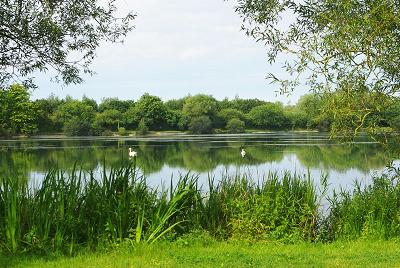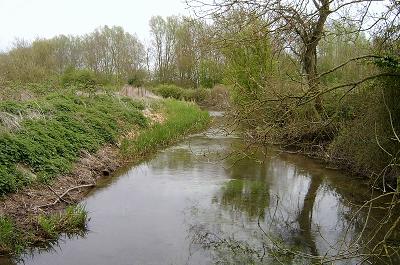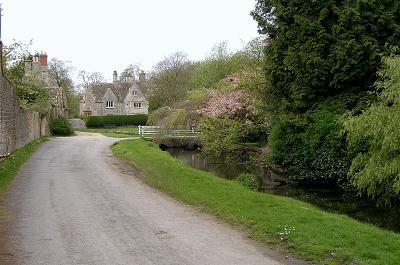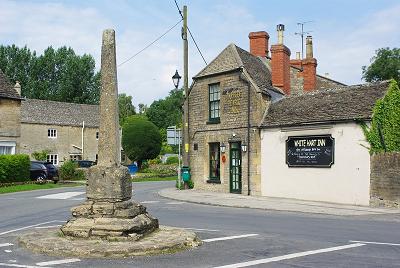Cotswold Water Park
I cross a wooden footbridge and suddenly there is a dramatic change in the landscape. Without warning there are lakes, and there are lots of them.
 Neigh Bridge
Neigh Bridge
I have arrived at Neigh Bridge Country Park which is just one of over 140 lakes that make up the Cotswold Water Park. The total area covered by the water park is around 40 square miles and the guide book claims that this complex is the largest inland man-made water feature in Europe.
The natural grassy pathway has been transformed into a gravel and pebble surface that winds its way between the lakes. A whole new environment is opening up around me.
I am a little surprised by the number of people that are here going about their various leisure pursuits. There are bird watchers, anglers, cyclists, boaters as well as plenty of other walkers all enjoying the tranquil lakes in their own preferential way.
So how come all of these lakes are here in the first place? To answer that question we have to go back millions of years to the time of the formation of the Cotswold Hills. Since their formation, the hills have been steadily eroded away by the elements and the sands and gravel were deposited here in this area of North Wiltshire. These deposits typically start at around one metre below the surface and the depths of the seams can be from just a few centimetres to more than six metres.
The sands and gravels have a high value in the construction industry and the mineral companies soon moved in. When the sand and gravel are removed it leaves behind a hole in the ground. With the relatively high water table in this area any hole of more than a metre depth rapidly fills with water, and “hey-presto” there is another lake!
Currently there are seven different mineral companies extracting two million tonnes of gravel per year. Fifty years of extraction has seen the creation of 147 lakes, and there is still an estimated 50 years of useful mineral resource remaining to be removed from the ground.
Cotswold Water Park was first designated in 1967 in order to make a better recreational and environmental use of what were then relatively ugly water-filled gravel workings. These former unsightly workings are being converted into a spectacular giant leisure park and nature reserve.
The first lakes were simple rectangular pits with steep, straight sides. This may have been simpler for extracting gravel, but for restoring the land afterwards it was totally useless. Improved restoration planning and design created inlets, islands and shallows that made the environment much healthier for both fish and wildlife. The region has literally blossomed ever since.
What a marvellous range of wildlife there is to be seen in this water-filled world. The bird spotters are out in force today, keenly observing the warblers and chiff chaffs. Shortly these birds will be joined by incoming willow warblers, sedge warblers and black caps. If I am very lucky I may catch a fleeting glimpse of one of the many kingfishers that have made the water park their home, but knowing how the fates play their games with me I will probably have to settle for being hissed at by a flock of Canada Geese.
The first dragonflies and butterflies are darting around in the air, and very soon the first of the orchids will open up their flowers. There are allegedly twenty three different species of dragonfly that can be found in the area including the relatively rare downy emerald dragonfly.
The abundant population of insects attracts their own predators, and consequently there are large numbers of bats that find this a veritable smorgasbord of delight. Believe it or not there are fourteen different species of bat who have made the water park their home.
On Flagham Fen a more adventurous wildlife project is underway. The lake is surrounded by an electrified fence which at first seems a little over the top to keep the stray walker out. A quick read of the many information boards around the perimeter soon reveals that it is not to keep people out; it is to keep its inhabitants in! European Beavers have been introduced as an experiment, and by all accounts they seem to be settling in nicely. The theory runs that these creatures will improve the ecology of the lake with their foraging and living habits allowing the plant-life to flourish without too much additional help from man. It will be wonderful if it is a success and these beautiful creatures can be integrated into this environment.
 Thames at Waterpark
Thames at Waterpark
The park is easily accessed by the public by over 150km of paths, bridleways and cycle-ways. Dotted among the lakes are fourteen picturesque villages with over 20,000 inhabitants.
I thought I had travelled all over our islands but this was all new to me. How could there be more than 40 square miles of lakes of which I had previously been unaware? Come on then, admit it; were you aware that this water-filled area existed before reading it here?
There is plenty of space to get away from it all before everyone else finds out about Cotswold Water Park. The park is not only a superb place for walkers and cyclists but also an excellent peaceful retreat for families to relax by the many lakesides. Family games of tennis and cricket were under way, frisbees span through the air and the occasional colourful kite could be seen in the sky.
As is usual in these situations, there are also kites that never rise more than a few feet before crashing back to earth again. How is it that some people are naturals when it comes to flying kites, while others are; let us be honest - hopeless. Isn’t it difficult to stop yourself being too obvious as you try to make it appear that you are not looking as Dad tries unsuccessfully yet again to get the kid’s kite airborne? The children, of course, have long since tired of this game and given up all hope of ever seeing their new toy take its promised place in the stratosphere. They are sitting with Mum, ice-creams in hand, having so much more fun laughing at Dad’s evermore desperate attempts and delighting in his rapidly increasing frustrations. Meanwhile Mum is making helpful diplomatic comments such as “Is everything OK dear?”, and “Perhaps it’s not the right wind for kites today”, while all the time trying not to stare enviously at the George Clooney look-alike fifty yards away who has both his son and daughter flying their kites high in the sky within a few seconds.
 Ashton Keynes
Ashton Keynes
Ashton Keynes is the largest of the villages in the area. It takes its name from the de Kaines family who arrived with William the Conqueror and stayed with us, taking over these local lands from the resident Saxons.
That great chronicler of England, William Cobbett, described Ashton Keynes as “a very curious place” when he passed through in 1826. The river here divides into several channels, each squeezing its way through different parts of the village before joining up again to continue on its way. Many of the streams run parallel with pathways, and small stone bridges have been built across the streams to give access to properties, making a sort of rural miniature version of Venice. Delightful well-maintained cottage gardens add their colour and it seems that everywhere I turn there is another “chocolate box” scene to attract the eye.
As I come to the main road through the village I discover an old stone “Preaching Cross”. The village boasts a total of four such crosses. Quite why such a small place possesses as many as four of them is a mystery that I did not find an answer to in my researches. It is, however, no surprise that after finding four crosses in such close proximity to discover that the village church is very appropriately named “Holy Cross”. A previous generation showed their imagination by converting the cross situated in the churchyard to its current use as the village war memorial.
All of the crosses were damaged during the Civil War by the Roundheads, who I discovered were responsible for quite a lot of the vandalism to our heritage in this part of the country. “The Roundheads are coming” must have spread the same fears in the local community in the seventeenth century as would happen today if the village football club suddenly found themselves drawn at home to Millwall in the FA Cup.
 White Hart and Preaching Cross
White Hart and Preaching Cross
The pathway turns left at the road junction, but I ignore the demands of the way-marker and instead turn right to seek out the White Hart, which is just a little way along the road. Another one of the preaching crosses stands proudly outside the pub. Inside there are original paintings decorating the walls and the general ambience provides a bright and cheery welcome for the weary walker.
Fortified by a couple of pints and a crispy bacon baguette I return to the pathway and follow it as it threads through the village, first following a lane and then cutting across the playing fields. Soon I am back among the lakes. An area to my left is fenced off and displays the stern warning “Dangerous Quicksand”. The vengeful thought passed through my mind that it would have restored some justice if these quicksands had previously managed to trap the vandalising Roundheads in revenge for the damaged crosses as they made their route out of the village.
The peace is broken by a distant hum, which slowly increases in volume as I walk along. The sound reaches a full roar and I turn a corner to discover a new lake before me. The noise is caused by a water-skier who is in sole possession of the lake. One of the huge advantages this complex has is its ability to allocate specific territories to those whose recreation is not fully compatible with that of others. One can appreciate that this particular enthusiast would not endear himself to yachtsmen as they sail around, and most certainly would unsettle the bird population and their attendant twitchers. Here the skier can blast across the water on his own allocated lake without the risk of upsetting other users. I decide to sit and watch for a while, but the skier seems pretty well in control and a dramatic plunge into the water just for my entertainment seems unlikely, so I move on.
All of the time since I left Ashton Keynes the Thames has worked its own way through the gravel pits, but now we are re-acquainted and travel together towards Cricklade. The tower of the Parish Church of St Sampson’s becomes visible in the distance, creating a destination marker for the end of day one.
Before I reach the town there is the botanical highlight of the day.
< Previous Page | Next Page >